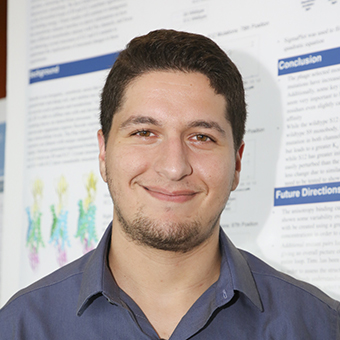Abraham Cheloff
 Miller Laboratory
Miller Laboratory
Department of Biochemistry
Brandeis University
Characterization of Monobody Interactions with EC2 Fluoride Ion Channel by Fluorescence Anisotropy
Poster Abstract
The Fluc ion channel family is comprised of dimeric membrane proteins functioning to expel excess F- from the cytoplasm of microorganisms to resist inhibitory effects of this environmental xenobiotic anion. Recent structures of an E. coli Fluc homolog, EC2, bound to engineered “monobody” proteins selected from phage display libraries, reveal multiple side-chain contacts at the channel-monobody interface. Two such monobodies, S9 and S12, share a similar interface structure, but their nanomolar-range binding affinities differ by ~5 fold. We focus on the per-residue energetic contributions to the binding affinity of S12 to Fluc by introducing point mutations at polar contacts on either side of the interface, assessing the change in binding affinity using fluorescence anisotropy. We have found that many of the residues on the diversified loops of S9 and S12 contribute significantly to the binding energy. Future studies will continue to mutagenize the monobody-channel interface to derive information on how these different monobodies interact with Fluc channels, and focus on obtaining crystal structures of S12 and its mutants to understand the implications of structural changes in these experiments.
Personal Statement
I was able to continue my research through the summer in Chris Miller’s lab due to the fellowship supported by the Bauer Foundation. I was presented with the opportunity to delve into different areas of protein science without many of the distractions of the school year, such as classes and extracurriculars. By focusing on the direction of my project, along with the acquisition of new skills and techniques, my project has grown significantly in breadth, and will hopefully continue to do so during the coming year. The summer research experience built my self-confidence in research, gave me the resources necessary to overcome the steep scientific learning curve, and to complete more complex and involved procedures. The strides of accomplishment from this summer will allow me to continue with my senior thesis project in the coming academic year.